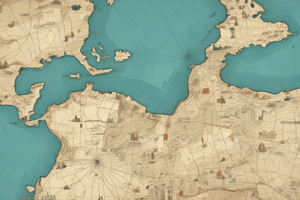Podcast
Questions and Answers
What is a scale map and how does it work?
What is a scale map and how does it work?
A scale map is a map that contains a scale, which is a ratio of two numbers. The first number represents the map, and the second number represents the corresponding place in real life. For example, a scale of 1:18,000 means that one unit on the map is equal to 18,000 units in real life.
What is the purpose of a bar scale on a map?
What is the purpose of a bar scale on a map?
A bar scale is a line on the bottom of some maps that shows a distance on that particular map. It provides a visual representation of the distance between two points on the map.
If the distance on the map from point A to point B is one inch, what would be the actual distance between the two points in real life?
If the distance on the map from point A to point B is one inch, what would be the actual distance between the two points in real life?
The actual distance between point A and point B would be 18,000 inches in real life. This is because the scale of 1:18,000 means that one inch on the map represents 18,000 inches in real life.
Why do we convert the units on a scale map into something more recognizable?
Why do we convert the units on a scale map into something more recognizable?
How can we convert the units on a scale map from inches to feet?
How can we convert the units on a scale map from inches to feet?
Explain the concept of scale in a map and how it is represented.
Explain the concept of scale in a map and how it is represented.
Give an example of how to convert units of measurement using a scale map.
Give an example of how to convert units of measurement using a scale map.
What are the four steps involved in creating a scale map?
What are the four steps involved in creating a scale map?
Explain the concept of measurement consistency when using objects to measure on a scale map.
Explain the concept of measurement consistency when using objects to measure on a scale map.
What does a scale of 1:4,800 represent in a scale map?
What does a scale of 1:4,800 represent in a scale map?
Flashcards are hidden until you start studying




